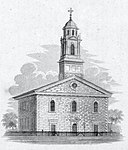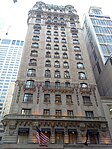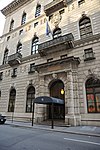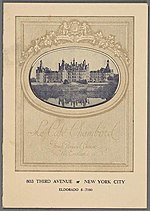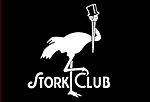689 Fifth Avenue

689 Fifth Avenue (originally the Aeolian Building and later the Elizabeth Arden Building) is a commercial building in the Midtown Manhattan neighborhood of New York City, at the northeast corner of Fifth Avenue and 54th Street. The building was designed by Warren and Wetmore and constructed from 1925 to 1927. The fifteen-story building was designed in the neoclassical style with French Renaissance Revival details. The primary portions of the facade are made of Indiana Limestone, interspersed with Italian marble spandrels, while the upper stories are made of decorative buff-colored terracotta. The first nine stories occupy nearly the whole lot, with a rounded corner facing Fifth Avenue and 54th Street. On the 10th, 12th, and 14th floors, the building has setbacks as mandated by the 1916 Zoning Resolution, and the building contains several angled sections. The decorative details include urns at the ninth-story setback, garlands, and a mechanical penthouse with a pyramidal roof and a lantern. 689 Fifth Avenue was commissioned by iron and steel magnate Charles A. Gould, who died before the building's completion. His daughter Celia Gould Milne bought the structure at an auction in 1927 and kept it until 1944. The building was the headquarters of the Aeolian Company, an instrument manufacturer, until 1938. Afterward, the storefront was renovated and the building's upper stories were used by a variety of office tenants. During the mid-20th century and late 20th century, the building was also named for Elizabeth Arden, Inc., which occupied the northern storefront and some office space for eight decades. The southern storefront has been used by numerous tenants including Gucci, Zara, and Massimo Dutti. The New York City Landmarks Preservation Commission designated 689 Fifth Avenue as an official landmark in 2002.
Excerpt from the Wikipedia article 689 Fifth Avenue (License: CC BY-SA 3.0, Authors, Images).689 Fifth Avenue
5th Avenue, New York Manhattan
Geographical coordinates (GPS) Address External links Nearby Places Show on map
Geographical coordinates (GPS)
| Latitude | Longitude |
|---|---|
| N 40.761055555556 ° | E -73.974888888889 ° |
Address
5th Avenue 689
10022 New York, Manhattan
New York, United States
Open on Google Maps
